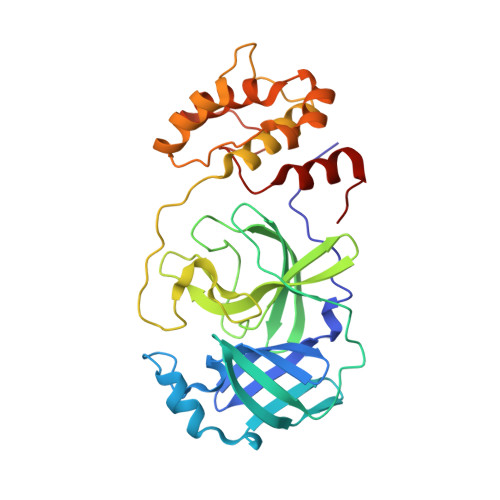Crystallization of Feline Coronavirus M pro With GC376 Reveals Mechanism of Inhibition.
Lu, J., Chen, S.A., Khan, M.B., Brassard, R., Arutyunova, E., Lamer, T., Vuong, W., Fischer, C., Young, H.S., Vederas, J.C., Lemieux, M.J.(2022) Front Chem 10: 852210-852210
- PubMed: 35281564
- DOI: https://doi.org/10.3389/fchem.2022.852210
- Primary Citation of Related Structures:
7SMV, 7SNA - PubMed Abstract:
Coronaviruses infect a variety of hosts in the animal kingdom, and while each virus is taxonomically different, they all infect their host via the same mechanism. The coronavirus main protease (M pro , also called 3CL pro ), is an attractive target for drug development due to its essential role in mediating viral replication and transcription. An M pro inhibitor, GC376, has been shown to treat feline infectious peritonitis (FIP), a fatal infection in cats caused by internal mutations in the feline enteric coronavirus (FECV). Recently, our lab demonstrated that the feline drug, GC373, and prodrug, GC376, are potent inhibitors of SARS-CoV-2 M pro and solved the structures in complex with the drugs; however, no crystal structures of the FIP virus (FIPV) M pro with the feline drugs have been published so far. Here, we present crystal structures of FIPV M pro -GC373/GC376 complexes, revealing the inhibitors covalently bound to Cys144 in the active site, similar to SARS-CoV-2 M pro . Additionally, GC376 has a higher affinity for FIPV M pro with lower nanomolar K i values compared to SARS-CoV and SARS-CoV-2 M pro . We also show that improved derivatives of GC376 have higher potency for FIPV M pro . Since GC373 and GC376 represent strong starting points for structure-guided drug design, determining the crystal structures of FIPV M pro with these inhibitors are important steps in drug optimization and structure-based broad-spectrum antiviral drug discovery.
- Department of Biochemistry, University of Alberta, Edmonton, AB, Canada.
Organizational Affiliation:

















